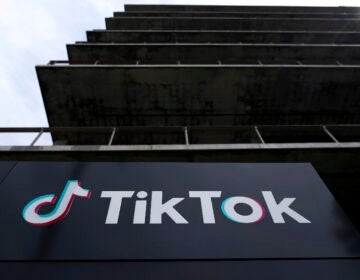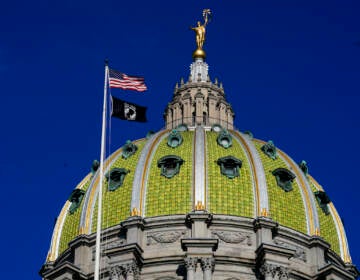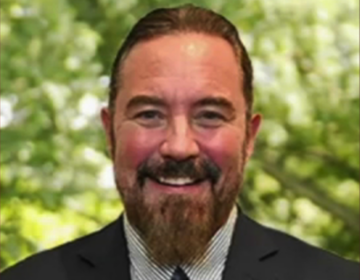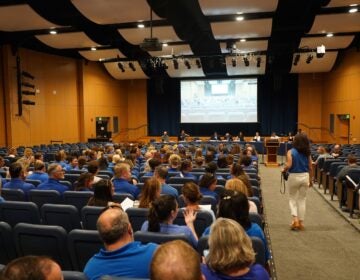After targeted TikTok campaign, Great Valley teachers are pushing for a digital citizenship curriculum
Students in the Malvern district impersonated their teachers on social media. Schools across Chesco and the U.S. are wondering how to adapt amid ever-changing technology.
Listen 1:09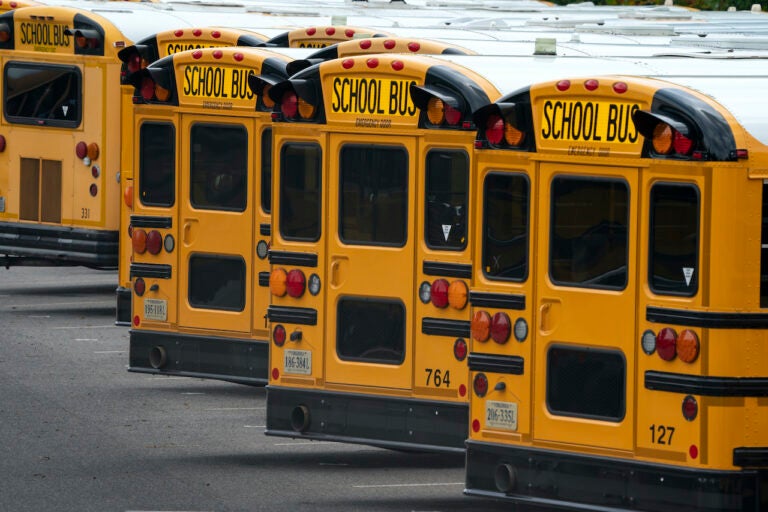
School buses are lined up at a maintenance facility. (AP Photo/J. Scott Applewhite)
From Philly and the Pa. suburbs to South Jersey and Delaware, what would you like WHYY News to cover? Let us know!
The Great Valley Board of School Directors is meeting Monday for the first time since the New York Times published a story, detailing how a group of middle schoolers targeted their teachers on social media.
The teacher’s union has requested its nearly 400 members to attend the meeting in solidarity with the affected teachers — and to show a willingness to work with the school board to find a solution.
The targeted campaign against the 22 educators at Great Valley Middle School began in February.
School districts across Chester County and the country are wondering how to adapt to a constantly-changing digital age. Nikki Salvatico, president of the Great Valley Education Association, said that finding a solution requires a collective lift from the entire community.
“None of us are immune from anything in this world,” she said. “What happened here could happen somewhere else and that’s the unfortunate thing, but we can band together.”
School board members did not respond to multiple emailed requests for comment. The meeting is scheduled for July 15 at 7 p.m. at the district office.
“Our attendance is always done in a very professional manner,” said Salvatico. “We’re there just to come as a unit to show that mainly, we want to work together with the district.”
U.S. Rep. Chrissy Houlahan has been in close contact with union leadership. Salvatico said she asked Houlahan to take her teachers to Capitol Hill.
“We want to lobby for federal legislation,” Salvatico said.
What happened at Great Valley Middle School? Inside the online harassment campaign
The Great Valley School District serves roughly 5,000 students from Malvern Borough as well as Charlestown, East Whiteland and Willistown townships.
The seventh and eighth graders, who launched the social media attack, created fake TikTok accounts impersonating their teachers. According to the New York Times, the students “posted disparaging, lewd, racist and homophobic videos.”
“I do give our middle school administrative team a lot of kudos for the hours, days and even weeks that they put into investigating trying to uncover who the perpetrators were,” Superintendent Dr. Daniel Goffredo told WHYY’s “Studio 2.” “Upon after a few days — learning that it was in fact middle school students, we reached out to our community. We made sure our parents were aware.”
Goffredo said “wounds” were inflicted upon his teachers.
School officials said they’re limited to the extent by which they can punish students. While many of the accounts have since been deleted, the Inquirer reported that the summer has brought the creation of new dummy profiles.
Cristina Hartley, co-president of the Great Valley Middle School PTO, told “Studio 2” that the incidents have cast a shadow over the district.
“These actions have caused a lot of stress on families like mine who respect the teachers and the administration and now the entire district is viewed through the actions of a few students who made very poor decisions and the lack of parenting,” Hartley said.
Like Salvatico, Hartley expressed a desire for collaboration amongst parents, teachers and administrators in and out of the classroom.
“Families need to work with the school and there are rules that we need to impose on our children at home and control what they do on social media,” Hartley said. “Not a free-for-all.”
Great Valley educators call for a digital citizenship curriculum
Salvatico, a first grade teacher in the district, has not gotten many direct responses from the community regarding the TikTok controversy.
But what little she has received mainly dealt with how the community can help teachers establish a safe learning environment.
She said one way the district can make that possible is through a digital citizenship curriculum.
“We need to educate them — parents, ourselves, every stakeholder in the community — and help them learn how to safely navigate and utilize their technological tools that we hand them,” Salvatico said.
From creating a cellphone free environment to applying camera clips to school iPads, Salvatico said there are also physical tools the district should explore to clamp down on unrestricted technology usage inside of the building.
“We have all kinds of boundaries we have to live by day-by-day,” Salvatico said. “So it’s just part of a life skill and another tool in their toolbox to be safe in the classroom.”

Get daily updates from WHYY News!
WHYY is your source for fact-based, in-depth journalism and information. As a nonprofit organization, we rely on financial support from readers like you. Please give today.



